

Hotels
Top in Pakistan

Hotels
Top in Pakistan
- Phone:+1 (859) 254-6589
- Email:info@example.com
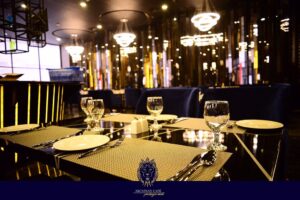
Restaurants
Delicious Restaurants

Tour & Travels
Explore Nature

Travel
Travel Agencies
The 10 Best Places to Visit in Lahore
If you are fascinated with historical sites, Lahore is your ideal destination. The Historical Museum is highly recommended for its noteworthy collection of forts, architectural marvels, and ancient buildings dating back to the Mughal era. Each of these old sites emanates a remarkable sense of originality. Discover the enchantment of the exquisitely conserved town centres with their captivating attractions and landmarks! Ourguider.com has curated a collection of the most exquisite historical sites for your exploration. Additionally, there are genuine insider recommendations.
A quick overview of the most exquisite destinations in Lahore
Each antiquated location possesses its distinctive essence. At the Zoo, you may witness the grandeur of elaborate monuments, while at the Museum, you can immerse yourself in the unadulterated history. You can leisurely walk across the expansive expanse of Lahore, and in the historic district of old Lahore, you can immerse yourself in the labyrinthine pathways.
Certain antiquated establishments managed to endure due to their decline in significance, thereby evading the process of modernization. Valuing and safeguarding the aesthetic appeal of a historic town necessitates significant financial resources and meticulous preservation efforts. Exploring Lahore’s exquisite ancient towns and historical sites is a worthwhile endeavour throughout the year. It offers an opportunity for an enriching voyage of exploration and discovery. We list down the top 10 places to visit in Lahore below:
- Badshahi Mosque
- Lahore Fort (Shahi Qila)
- Shalimar Gardens
- Wazir Khan Mosque
- Jahangir’s Tomb
- Sheesh Mahal
- Minar-e-Pakistan
- Lahore Museum
- Lahore Zoo
- Bagh-e-Jinnah (Lawrence Gardens)
1: Badshahi Mosque
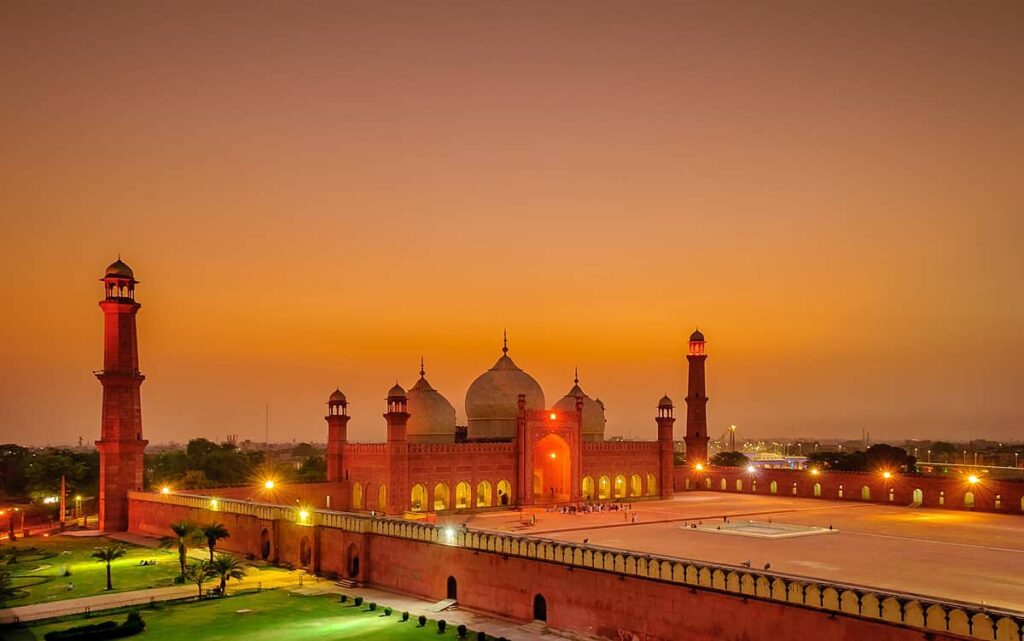
The Badshahi Mosque is a renowned Mughal-era mosque in Lahore, Punjab, Pakistan. The mosque is situated across from Lahore Fort on the fringes of the Walled City and is widely regarded as one of Lahore’s most renowned landmarks.
The construction of the Badshahi Mosque took place from 1671 to 1673 under the patronage of the Mughal emperor Aurangzeb. The mosque exemplifies Mughal architecture, including an adorned facade crafted from intricately carved red sandstone embellished with marble inlay. The mosque still has the title of being the largest mosque from the Mughal era and is currently the third-largest mosque in Pakistan.
Management Services
If you have not yet had the chance to visit Lahore, it is worth noting that the Muslim religion is highly tolerant in that city. Evidence of this mindset is demonstrated by the fact that it is feasible to tour the mosques in Lahore or at least the overwhelming majority. Furthermore, admission is entirely complimentary, although it is advisable to consider contributing to departure.
The sole need is that individuals adhere to the regulations. As anticipated, this entails abandoning shoes at the entry or transporting them in a bag.
2: Lahore Fort (Shahi Qila)
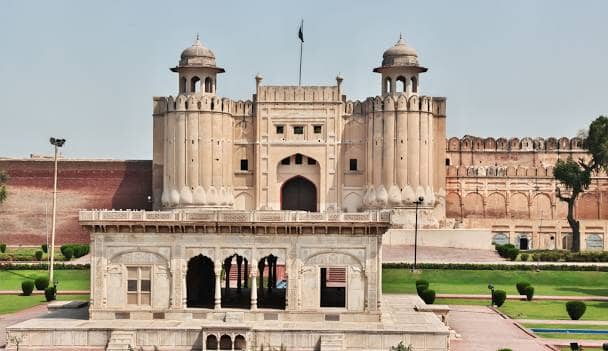
The Lahore Fort is a fortress located in the city of Lahore in Punjab, Pakistan. The castle is situated at the northern terminus of the Walled city of Lahore and covers over 20 hectares (49 acres). The area encompasses 21 prominent landmarks, a few of which may be traced back to the reign of Emperor Akbar. The Lahore Fort underwent extensive reconstruction throughout the 17th century, a period of great prosperity and luxury for the Mughal Empire.
Lahore Fort, also known as Shahi Qila, is a citadel in Lahore, Punjab, Pakistan. The fort has a rich history, having been constructed and rebuilt by various rulers from different eras, which gives it a unique architectural character that combines several styles and influences. Here is an architectural overview of the Lahore Fort:
Historical Context
The origins of Lahore Fort date back to antiquity, but the current structure was primarily built during the Mughal era. Significant contributions were made by Emperor Akbar, followed by subsequent additions and modifications by Jahangir, Shah Jahan, and Aurangzeb. The fort also saw modifications under Sikh and British rules, adding to its eclectic architectural heritage
3: Shalimar Gardens
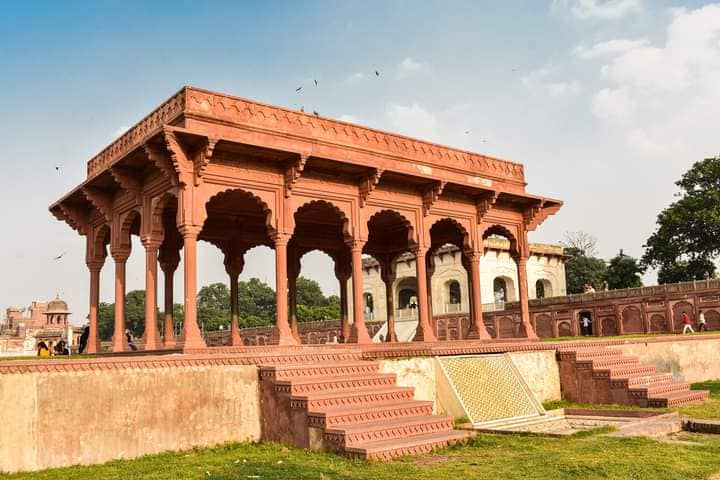
The Shalimar Gardens are an intricate garden complex of Mughal origin situated near Lahore. The gardens were established during the peak of the Mughal Empire’s architectural and aesthetic excellence and are currently one of Pakistan’s most sought-after tourist attractions.
The Shalimar Gardens were designed as a Persian paradise garden to depict an ideal earthly paradise where humans live in complete harmony with all aspects of nature. The construction of the gardens commenced in 1641 under the rule of Emperor Shah Jahan and concluded in 1642. The Shalimar Gardens were designated as a UNESCO World Heritage Site in 1981 due to their embodiment of the pinnacle of Mughal garden design.
Cultural History
The range of garden types is varied, as gardens and parks have always been created to fulfil distinct or various design, form, and function requirements. The gardens have consistently served as spaces for joyful socializing, learning, or serene unwinding. The development and evolution of these institutions are closely linked to shifts in the perception of nature, the portrayal of societal norms, and a consistent need for instruction in cultural history. Additionally, they are precious areas that exhibit a wide range of biodiversity, provide essential ecosystem services, offer recreational opportunities, and serve as important sites for environmental education. Historical gardens, as cultural assets, can contribute to formulating and implementing sustainable action objectives in contemporary society, specifically about the ethical meaning of life. They can initiate and perpetuate these goals within existing civilization processes. This exhibition showcases a diverse range of foreign examples that highlight the significance of these cultural monuments in addressing current sustainability concerns, such as climate change and the modern interaction between humans and nature.
4: Wazir Khan Mosque
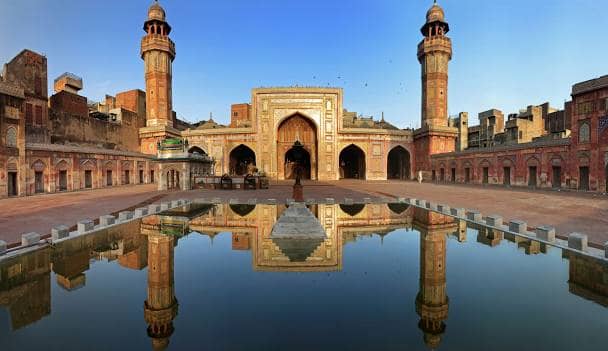
The Wazir Khan Masjid is a Mughal masjid from the 17th century in Lahore, Punjab, Pakistan. The Mughal Emperor Shah Jahan commissioned the mosque during his reign. It was built as part of a group of buildings, including the adjoining Shahi Hammam facilities. The construction of Wazir Khan Mosque commenced in 1634 C.E. and concluded in 1641. It has been included in the UNESCO World Heritage Tentative List.
The Wazir Khan Mosque is widely recognized as the most intricately adorned mosque from the Mughal era. It is famous for its detailed faience tile work, known as kashi-kari, and its interior surfaces are extensively decorated with beautiful frescoes from the Mughal era. The mosque has undergone significant renovation since 2009, overseen by the Aga Khan Trust for Culture and the Government of Punjab, with financial support from the governments of Germany, Norway, and the United States.
Architecture
The inside of the mosque prominently displays historical elements such as the minbar, mihrab, low-hanging chandeliers, and Islamic inscriptions. In addition, numerous remarkable artefacts and masterpieces are on display, including urns, pillars, and doors. Additionally, countless remarkable Christian mosaics are adorning the walls.
5: Jahangir's Tomb
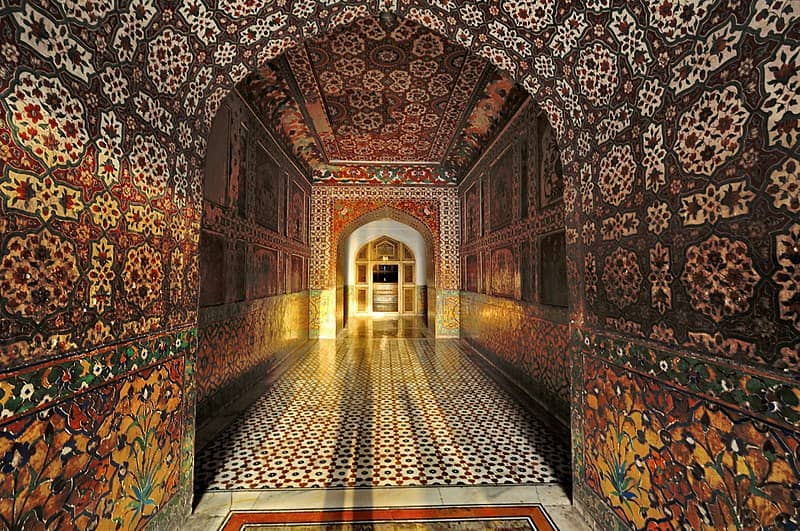
The Tomb of Jahangir is a sepulchre constructed in the 17th century to honour the Mughal Emperor Jahangir. The mausoleum was built in 1637 and is situated in Shahdara Bagh, near Lahore, Pakistan, on the banks of the Ravi River. The property is renowned for its lavishly adorned interiors with frescoes and marble and its grandly designed exterior adorned with pietra dura. The mausoleum, the nearby Akbari Sarai, and the mausoleum of Asif Khan are included in a group of structures currently being considered for inclusion on the UNESCO World Heritage list.
Architectural History
The imperial tomb has been transformed into a freestanding marble structure supported by a three-tiered base of two sandstone layers. The cover plate features depictions of Emperor Jahangir adorned in regal attire. The tomb is decorated with scenic reliefs and architectural decorations on three out of its four sides. The reliefs portray episodes from the saints’ tales, while the lower steps beneath the reliefs are adorned with diverse reptiles. The portrayal of the imperial mausoleum is enhanced by areas adorned with gold and the judicious use of black, crimson, and green hues. Two bronze inscriptions were affixed to the vacant western side of the tomb.
6: Sheesh Mahal
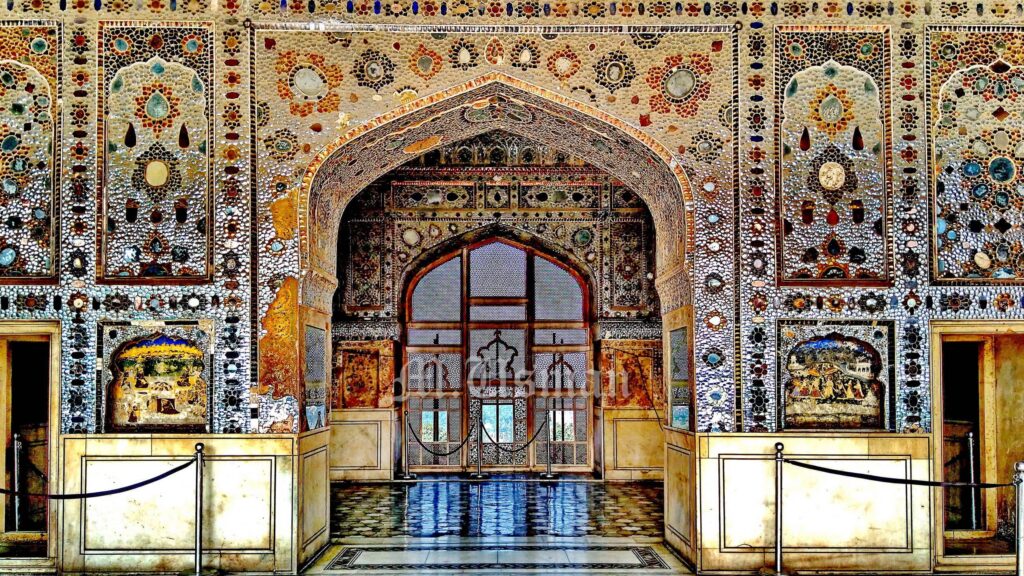
The Sheesh Mahal is a palace in the Shah Burj block at the northwestern corner of Lahore Fort. The construction of this monument took place during the rule of Mughal Emperor Shah Jahan in 1631–32, and some additional features were added subsequently during the reign of Sikh Maharaja Ranjit Singh. The elaborate white marble pavilion is adorned with intricate pietra dura and intricate mirror-work of the highest calibre. The hall was exclusively designated for the private use of the imperial family and their closest associates. It is one of the 21 monuments constructed by successive Mughal rulers within Lahore Fort and is considered the most important. The Lahore Fort Complex, including this particular site, has been officially recognized and listed as a UNESCO World Heritage Site since 1981.
Historical Heritage
Sheesh Mahal is one of the historic palaces in Pakistan, situated in the heart of old Lahore within the Lahore Fort. Constructed during the 16th century, its initial purpose was to serve as the dwelling for the mayor and his officials, hence its name. The Sheesh Mahal, located in Lahore, is a renowned medieval palace. It is an architectural complex that is intersected by two streets. At this intersection, visitors can appreciate the beauty of the Moti Masjid. The bell is used to notify the populace of noteworthy occasions. The tower is renowned for its historical use as a location for public executions, which were seen from as far away as Minar-e-Pakistan. Today, the vault continues to pique the interest of travellers due to the unique acoustics of its walls. When one speaks softly while facing one of the four corners, a person positioned in front of one of the opposite corners can discern the conversation from the other side.
7: Minar-e-Pakistan
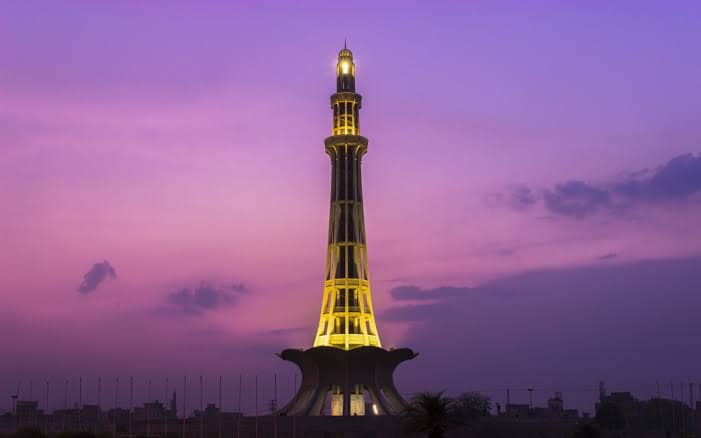
Minar-e-Pakistan is a structure situated in Lahore, Punjab. The tower was constructed from 1960 to 1968 at the location where the All-India Muslim League adopted the Lahore Resolution (later known as the Pakistan Resolution) on March 23, 1940. This resolution marked the initial formal demand for a distinct and sovereign homeland for the Muslims of British India by the principles of the two-nation theory. The resolution ultimately contributed to the establishment of Pakistan in 1947.
The skyscraper is situated centrally within an urban park known as the Greater Iqbal Park. The architects responsible for the design of Minar e Pakistan are Husnain Sulehri and Ali Sarwar Khokhar.
Updation from time to time
Historic buildings provide a concrete connection to our past, reminding us of our predecessors’ challenges, victories, and customs. They offer a perception of identity and coherence and facilitate the development of robust cultural underpinnings within communities. By conserving these structures, we guarantee that future generations will have the chance to admire and gain knowledge from the heritage of their predecessors. Historic structures of Lahore places to visit possess the capacity to rejuvenate communities and stimulate economic expansion. When conserved and adapted, these edifices transform into appealing tourist attractions, offering prospects for local enterprises to flourish. Historic districts frequently transform into dynamic cultural hubs, featuring distinctive boutiques, eateries, and art galleries that draw in people from both local and distant areas. Furthermore, the preservation and upkeep of historical structures generate employment opportunities for artisans, architects, and other proficient labourers, thereby significantly contributing to the local economy.
8: Lahore Museum
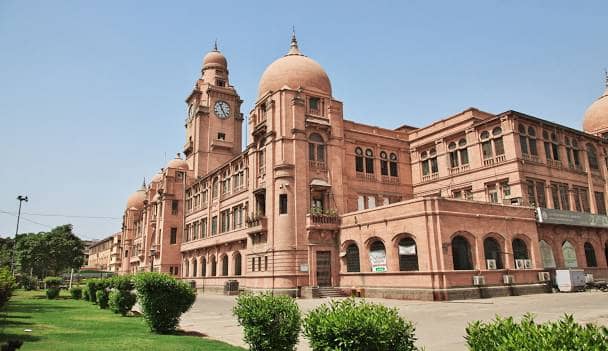
The Lahore Museum is situated in Lahore, Punjab, Pakistan. The Lahore Museum, established in 1865 and relocated to its current site on The Mall in Lahore in 1894 during the British colonial era, is Pakistan’s largest and most famous Museum. The Museum contains various Buddhist artworks from the ancient Indo-Greek and Gandhara realms. The Museum also houses artefacts from the Indus Valley Civilisation, the Mughal Empire, the Sikh Empire, and the British Indian Empire. The Lahore Museum, accompanied by the Zamzama Gun positioned directly in front of the structure, serves as the backdrop for the first scene in the novel Kim by Rudyard Kipling. It is worth noting that John Lockwood Kipling, the father of Rudyard Kipling, held the position of one of the Museum’s earliest curators.
Meaning of Museum
The Lahore museum, referred to as a plural of museums, is widely regarded as a sanctuary dedicated to the muses. However, what exactly does this designation entail? Does it imply that museums exclusively exhibit visually pleasing objects and solely present art and aesthetically pleasing creations?
Consequently, this implies that museums will exclusively exhibit art, which could be more complex and highlight one crucial aspect: our contemporary understanding of the muses is excessively narrow, considering that there were initially nine of them!
9: Lahore Zoo

The Lahore Zoo, located in Lahore, Punjab, Pakistan, was established in 1872 and is one of the largest zoos in the country. The Forest, Wildlife and Fisheries Department of the Government of Pakistan now oversees its management. The Zoo accommodates a diverse assemblage of over 1378 animals, representing 135 distinct species. The fifth annual conference of SAZARC took place at Lahore Zoo in 2004.
The Lahore Zoo is the third most ancient Zoo globally. The House of Vienna Zoo in Austria, initially founded in 1752 as a menagerie, was officially introduced to the public as a zoo in 1779. The London Zoo in England, founded in 1828, was made accessible to the general public in 1847. The Alipore Zoo in India, founded in the early 19th century, officially opened to the public as a zoo in 1876.
History of Zoo
Regarding the feral aspect of nature, individuals exercise great caution. The majority of feral and flesh-eating creatures remain outdoors. The rationale may be traced back to the original constitution: “Given that they can only be confined within enclosures, they are more appropriately classified as part of menageries.” Additionally, they possess the drawback of typically eliciting an unpleasant impact on the olfactory nerves. Some animal enclosures were disassembled and reconstructed at a different site.
Despite the Zoo’s expansion, the animals continue to reside in cramped conditions within enclosures. That remains unchanged in the subsequent decades. After the relocation, numerous new structures, such as the aquarium and authentically designed terrariums housing reptiles, were constructed. However, the primary objective of the Zoo remains to exhibit a large number of animal species, prioritizing quantity over quality.
The Zoo consistently endeavours to attract a more significant number of tourists through various attractions. Hot air balloon trips have been available since the late 1800s. Within middle-class social circles, having one’s photograph captured within the confines of a lion’s enclosure is deemed fashionable. The protective barriers that separate the animal from the human are naturally invisible.
10: Bagh-e-Jinnah (Lawrence Gardens)
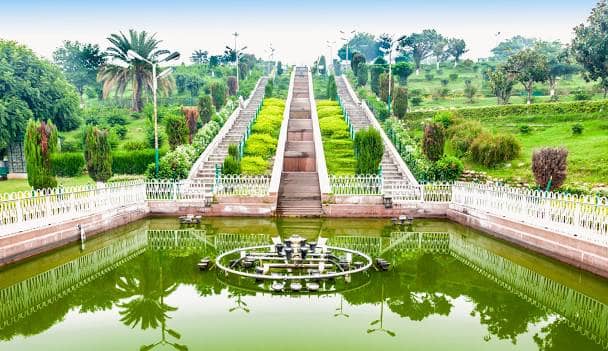
Bagh-e-Jinnah, previously named Lawrence Gardens, is a historic park in Lahore, Pakistan. The expansive verdant area encompasses a botanical garden, Masjid Dar-ul-Islam, and Quaid-e-Azam Library.
Bagh-e-Jinnah features a walking track.
The park also features several amenities for leisure and sports, including an outdoor theatre, a restaurant, tennis courts, and the Gymkhana Cricket Ground. The location is on Lawrence Road, adjacent to Lahore Zoo, opposite the Governor’s House on The Mall.
Gardening has long relied heavily on lawns and meadows. Throughout history, these are the best places to visit in Lahore; significant effort and meticulous attention were dedicated to the design, upkeep, and preservation of many types of outdoor spaces, such as the lawn bench during the Middle Ages, the lawn parterre in the Baroque period, and the incorporation of flower and park meadows as atmospheric elements in landscape parks. Specialized knowledge was sought for the proper soil preparation, seed acquisition, selection of grass combination, enrichment with flower seeds, and timing of mowing.
Choose Your Destination
Guide to Planning A Unforgettable Tour
Visit Lahore
Hunza Valley
Pak China Border
Swat Valley
Attabad Lake
Best Places to Visit in Islamabad
News & Blog
News & Blog
Everything You Need to Know While Booking A Hotel
Mid-range hotel, 5-star hotels in Lahore, all-inclusive, great location, or lodging in a hip neighborhood? If you need to figure…
Guests Require this Information When Choosing A Restaurant
Some of the best restaurants in Lahore make it difficult for guests to find the information they require while selecting…
What should you pay attention to when booking with a…
The Internet is whole of comparison sites and price search engines claiming to provide the best and lowest deals. Furthermore,…



